| 1 | Central American eyelash viper |
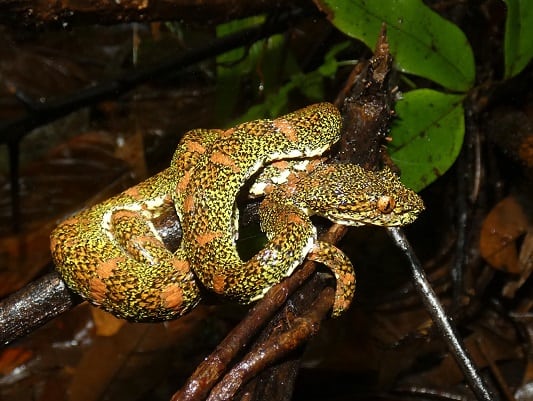
This venomous, branch-dwelling species belongs to the Bothriechis pitviper family (19 members), and is easily the most common member. They range from far southern Mexico through most of central America, to a small region of far western Colombia, meaning that Honduras lands squarely in the middle.
Central American eyelash vipers (Bothriechis nigroadspersus) spend most of their lives on trees or low bushes. They’re a relatively small venomous snake, with a maximum of 62.6cm in males and 91.6cm in females. Their name originates from horn extensions above each eye, which gives them a flirty appearance, and another characteristic is an extremely wide variety in colours. Banana yellow is most common, but pink, red and mossy green are all common, as is a “Christmas” morph of alternating red and green.
Its venom is no laughing matter, but far from severe. The LD50 toxicity rating is a respectable 1.6mg, yet the venom yield is low at 10-20mg. There are virtually no local symptoms except a pair of bite marks. All the symptoms are systematic, and even these aren’t severe. Nausea, paraesthesia (tingling), vomiting and cold sweats are common, with the most severe bites progressing to blood clotting difficulties.
Only a handful of deaths have been confirmed from this branch-dwelling viper. Eyelash vipers have a calm temperament, and you can walk right past their branches without them reacting. Nevertheless, it’s best not to taunt them, as they can strike with lightning speed when pushed.
| 2 | Highland garter snake |
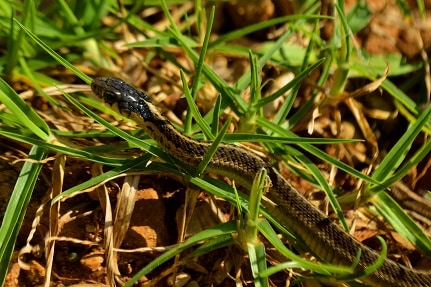
This species belongs to the same Thamnophis family as the US garter snakes, but lives nowhere north of extreme southern Mexico. Highland garter snakes range from 40-60cm (record 65.2cm), and its brown colours are believed to mimic the venomous Godman’s montane pitviper.
Honduras is at the epicentre of their range, particularly the central south of the country. Highand garter snakes (Thamnophis fulvus) live at high altitudes, ranging from 1000 to 3710 metres above sea level. They inhabit a variety of forest types, such as broadleaf and pine-oak, but also open areas, such as high altitude grassland strewn with jagged rocks and juniper bushes. These include mountainous areas carved by former ice age glaciers, with temperate climates closer to western Europe than the average rainforest.
Highland garter snakes prey mainly on amphibians, with one confirmed species being the poisonous salamander Bolitoglossa rostrata. When most snakes eat this amphibian, they lose all muscle control, becoming immobile and not even responding to a hard poke. The highland garter snake has evolved resistance somewhere along the line, similarly to the USA’s common garter snake, which is resistant to rough-skinned newt toxins. Highland garter snakes pose virtually no threat to human beings.
| 3 | Variable coral snake |
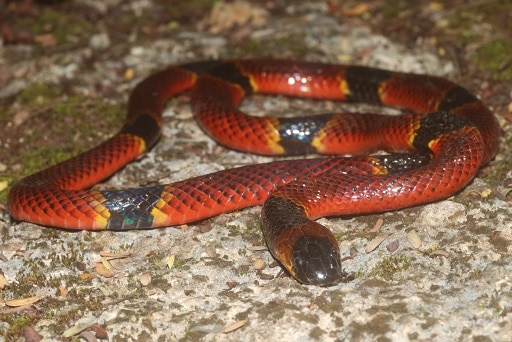
Of the 82 deadly coral snakes of the Americas, Honduras hosts four, with the variable coral snake (Micrurus diastema) being one of the more widespread. This species reaches a maximum so far of 98.2cm, and also inhabits Guatemala, Belize and far southern Mexico. This is a snake of forests, ranging from tropical deciduous to pine-oak forests.
Formerly called the Atlantic coral snake, this is one of the most variable (not surprisingly) coral snakes worldwide. The first classic morph is a simple alternating red and black, lacking the yellow of most coral snakes, except around the head and tail. This morph is very easy to distinguish from others. In other regions though, the yellow bands are visible, though far thinner than usual. One fairly consistent way to identify Micrurus diastema is that the red bands are usually smattered with tiny black spots.
Because the yellow is commonly missing, this is one species where you can never trust the old “red touches black, venom lack” rhyme. Its venom is little researched, but is confirmed to contain alpha-neurotoxins, which block acetylcholine receptors from detecting brain signals, leading to paralysis.
The variable coral snake’s prey includes other snakes, including our fellow list member Degenhardt’s scorpion eater. Other prey include Liebbman’s earth runner (Chersodromus liebmanni), coral earth snakes (Geophis semidoliatus), and snake eggs. The variable coral snake also has a harmless mimic in the form of variegated false coral snakes (Pliocercus elapoides).
| 4 | Bothriechis guifarroi |
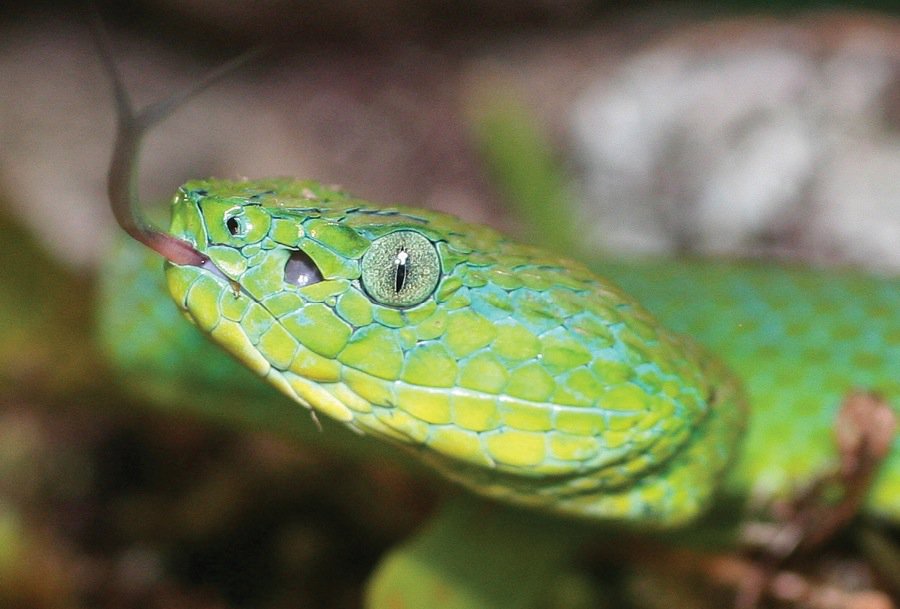
Bothriechis guifarroi belongs to the same genus as eyelash vipers, but while the eyelash viper were first identified in 1846, this species somehow stayed hidden in Honduras’ jungles until 2010. This all new species is a bright green colour, with emerald green eyes, and neon blue visible between its scales. As youths, they have two colours morphs, green and brown, which converge into a consistent adult green with age.
The first ever Bothriechis guifarroi was discovered in Texiguat Wildlife Refuge, northern Honduras, and measured 73.7cm. It was spotted in a rocky jungle stream, shaded by massive overhanging canopies. Genetic analysis soon proved it to be independent of all other members. This region of Honduras has two other Bothriechis pitvipers, but B. guifarroi snake is more closely related to Bothriechis nigroviridis in Costa Rica, 600km away.
Bothriechis guifarroi is primarily a forest species, especially favoring cloud forests, hilly jungles surrounded constantly by swirling fingers of mist. They prefer altitudes of 1015-1450 metres, and are venomous like all Bothriechis members, though with an unknown strength. Its name came from environmental campaigner Mario Guifarro, a former gold miner who was murdered while establishing a new environmental zone in Moskitia region in 2007. He also had a new beetle named after him in 2021: Phrynidius guifarroi.
| 5 | Mexican jumping viper |
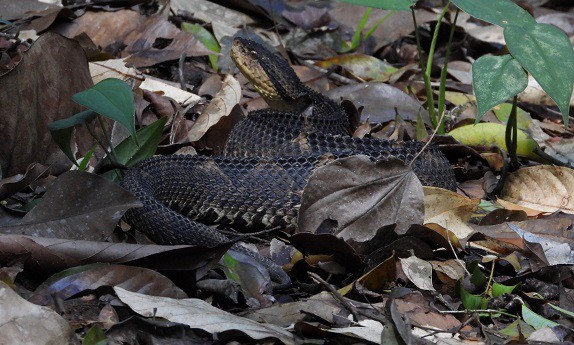
A small, stubby venomous snake found from far southern Mexico to Panama. Central American jumping vipers average at 50cm (max 97.9cm), and are probably the most inaccurately named snake in the world. Their name originated from a local belief that Mexican jumping vipers can pounce on victims from extreme distances. Not only can this species not jump, but their strike distance is very poor, mainly because their body is so thick.
This species appears at elevations of 40-1600 metres. Its habitats include rainforests and lower cloud forests, but also drier pine savannahs. Mexican jumping vipers are very alert, and are constantly swivelling their heads towards the slightest disturbance. Yet they’re also docile, and rarely attack just for the sake of it. They have a relatively weak venom, despite their cruel facial expressions.
In addition to being bulky, Central American jumping vipers (Metlapilcoatlus mexicanus) have a very short tail which isn’t prehensile. Consequently, they almost never climb trees, and they rarely even climb onto rocks to bask in the sun. A small bush is the highest this Honduran species climbs.
Metlapilcoatlus mexicanus has stereotypical viper patterns which could have been ripped from any species: brown contrasting against darker brown, with diamond patterns. A dense black stripe behind their eye is one way to recognise them.
| 6 | Slender snail sucker |
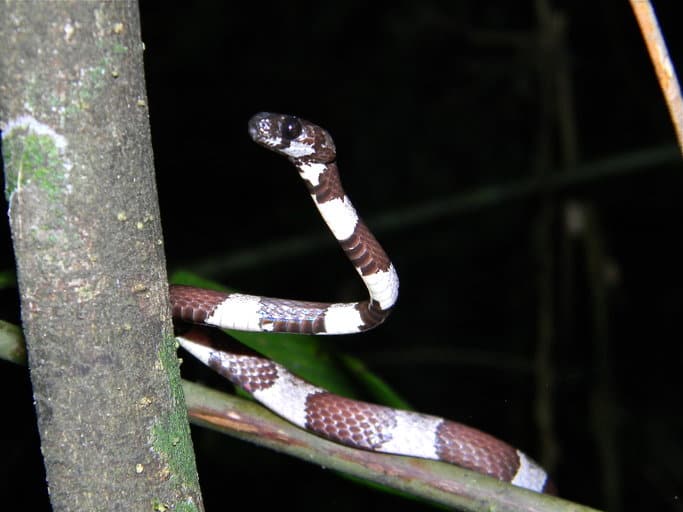
Sibon is a genus of snakes with 21 members, which mainly eat snails and slugs, and have especially large eyes. The slender snail sucker (Sibon dimidiatus) is one of the more widespread members in territory, appearing in all 7 Central American countries, as well as extreme southern Mexico.
Slender snail suckers reach a maximum of 80cm, and spend most of their lives on trees. They’re particularly common in forests at altitudes of 700-1500 metres, with rainfall totalling 1850-4000mm per year. Their most common habitat is dense cloud forests, cloaked in a dense mist for most of their day. Their diet is normal for the genus: mainly snails and slugs.
Despite being relatively widespread, this species is particularly difficult to find. As recently as 2019, only 15 slender snail suckers had been found in Honduras, yet its sightings are spread all over the country, showing that the elusiveness is because of their shy nature rather than occupying little territory.
This snake is naturally scarce, humans or no humans. Most sightings of Sibon dimidiatus are made during heavy rains at night, in humid forests. It’s possible to spend 12 years at a forested research station and never see this shy snake. In 2019, for example, the 14th and 15th snakes were found, which extended its known territory by 104km to the northwest. These were found in La Paz province, southwestern Honduras.
| 7 | Slender hognose pitviper |
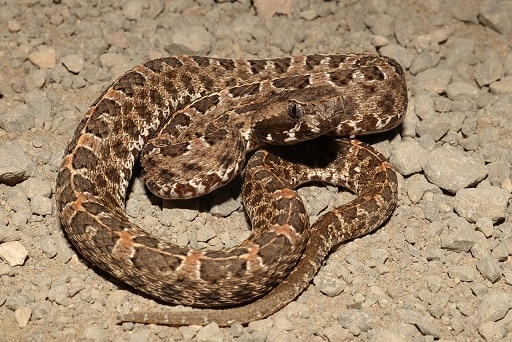
One of Honduras’ more common venomous snakes, a species that people should always be cautious around. Porthidium ophryomegas has alternating blotches of brown, contrasting sharply against toffee-coloured scales between. They average at 40-60cm, and even the most extreme female ever only reached 77cm. Nevertheless, size is irrelevant, as this species has caused 3 confirmed deaths, and almost certainly more in the past.
Slender hognose pitvipers occur in three further countries; Costa Rica, El Salvador and Guatemala. This species prefers lower altitudes, ranging from 0-1100 metres. They sometimes climb into low bushes, but rarely more than 1.5 metres off the ground. Slender hognose pitvipers prefer to rest under leaves, logs, discarded rubbish, and hollows in tree trunks, making it easy to stumble across them by accident. They’re a nocturnal species, and the rainier the night, the more likely this snake is to be spotted on the prowl. Slender hognosed pitvipers inhabit forests, and aren’t fussy about the exact type.
Porthidium ophryomegas is mostly a mammal-eating snake, with birds being second choice. After biting, they let go of their prey and watch them with their cunning vertical pupils, before slithering in to collect their prize after they finally succumb.
| 8 | Northern puffing snake |
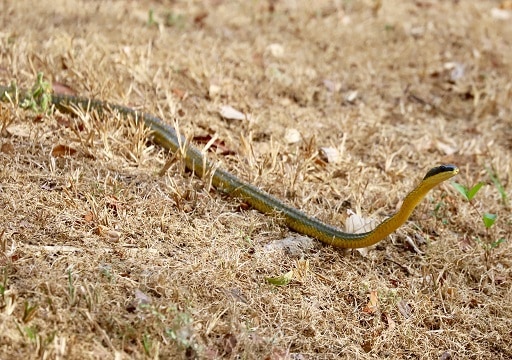
A common snake across most of central America. Northern puffing snakes (Phrynonax poecilonotus) are notorious for raiding bird’s nests, and swallowing their eggs whole, cracking them by stretching their own bodies taut like a rope. They belong to the Phrynonax family, which has 3 members. P. poecilonotus and P. polylepis are easily the most common members, but the latter is only found in South America, nowhere close to Honduras.
Phrynonax poecilonotus can push to 2 metres in the largest individuals. There’s a reason why this snake has prospered, as they have a determined personality and don’t hesitate to bite. Northern puffing snakes are non-venomous, but have a fearsome defensive display, rearing themselves up, inflating their chest grotesquely, and hissing aggressively. They’re a day-faring snake, and are commonly encountered by Honduran villagers, partly because of their large, 1.8 metre size which is difficult to miss. They inhabit a variety of forests, ranging from lowland rainforests to dry gallery forests on the edges of fields, bordered on each side by rivers.
One of the easiest signs to recognise in northern puffing snakes is their yellow lips, which contrast sharply against their tyre-black bodies. This is an extension of their purely yellow belly. Birds are their main prey, but also reptiles such as blue-lipped tree lizards.
| 9 | Middle American burrowing snake |
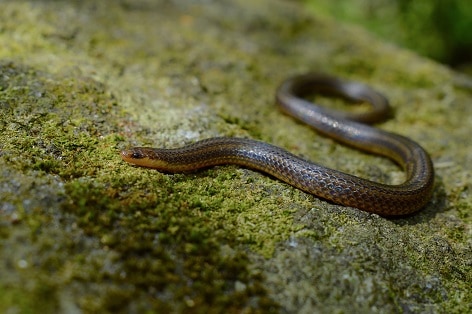
A species also found in Nicaragua, Belize and far southern Mexico. Middle American burrowing snakes are a shy, non-venomous creature, which reach a maximum of just 40cm. This is a wilderness snake, not one you’ll ever find in Honduras’ big cities.
This species prefers lowlands and foothills, unlike its close relative Adelphicos veraepacis, which prefers higher altitudes. Middle American burrowing snakes particularly like to hang out near streams in forests. At an average of 30cm, they’re only small, and survival in Honduras’ wilds is a struggle. They’re picked off by larger predators such as flathead knob-scaled lizards, and even spiders. Adelphicos quadrivirgatus was once found stuck in the web of a dark fishing spider, a semi-aquatic species. The web was 20cm above a stream, and the spider had managed to eat most of the flesh 3-4cm below the snake’s snout.
Adelphicos quadrivirgatus is a decent climber, sometimes laying its eggs in termite nests 1.5 metres above ground. Their small size has also pushed them towards a diet of earthworms (which might taste amazing for all we know).
| 10 | Degenhardt’s scorpion-eating snake |
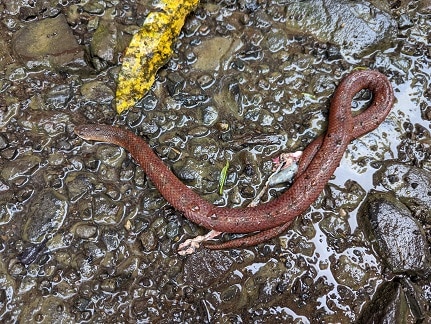
A docile snake average at 55cm (max 85cm), which can easily be watched from a distance swimming around the streams they reside in. Stenorrhina degenhardtii ranges from southern Mexico to Colombia, with Honduras having a plethora of daily sightings. This species resides in many habitats, including forests, agricultural fields, and areas near houses.
They vary in appearance as well, with some having dull grey blotches, but others being a bright rusty red colour. Some can be beige with red blotches, and others brown with darker brown bands. What’s consistent is that they’re a friendly-looking snake, with round hopeful eyes, featuring black pupils and an orange iris. Their belly is always slightly lighter than the rest of their body.
Stenorrhina degenhardtii is persistent, and will endure several sting attempts by angry scorpions (its main prey), before finally landing their teeth and chewing their venom in. Their prey includes the centurion scorpion, as well as a supplementary dose of spiders. One of their arch enemies in nature is the variable coral snake (our fellow list member), which is confirmed to prey on them.
Degenhardt’s scorpion eater has one other family member: Stenorrhina freminvillei. This also eats scorpions, and is also found in Honduras, but has far plainer patterns, usually a more consistent red colour, occasionally with vertical stripes.
